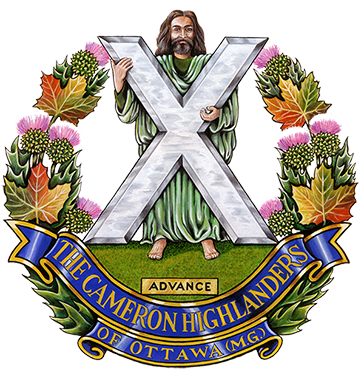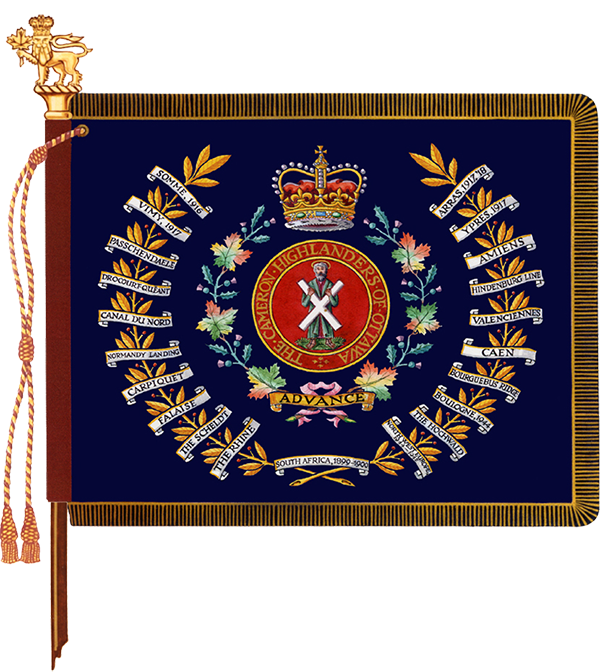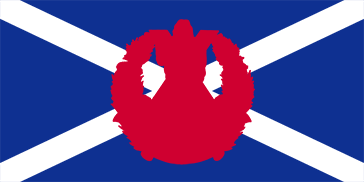The Cameron Highlanders of Ottawa (Duke of Edinburgh's Own)
The official lineage of The Cameron Highlanders of Ottawa (Duke of Edinburgh's Own) infantry regiment.

Colonel-in-Chief: Vacant
Badge
Description
The figure of St. Andrew proper holding his cross Argent and standing on a mount Vert set with a plaque Or inscribed ADVANCE in letters Sable, all within a wreath of thistles and autumn maple leaves proper issuant from two scrolls Azure edged and inscribed THE CAMERON HIGHLANDERS and OF OTTAWA (M.G.) in letters Or.
Symbolism
The maple leaves represent service to Canada. The thistles (the national flower of Scotland) and the cross held by St. Andrew (the patron saint of Scotland) are common devices in badges of highland infantry. “THE CAMERON HIGHLANDERS OF OTTAWA (M.G.)” is the 1936-1959 regimental title, and “ADVANCE” is the motto of the regiment.
Motto
ADVANCE
Marches
“The Piobaireachd of Donald Dhu” and “March of the Cameron Men”
Alliance
British Army
The Royal Regiment of Scotland
Regimental colour

Camp flag

Battle honours
South African War
SOUTH AFRICA, 1899-1900.
The First World War
MOUNT SORREL; SOMME, 1916; Ancre Heights; Ancre, 1916; ARRAS, 1917, '18; Vimy, 1917; YPRES, 1917; Passchendaele; AMIENS; Scarpe, 1918; Drocourt-Quéant; HINDENBURG LINE; Canal du Nord; VALENCIENNES; SAMBRE; FRANCE AND FLANDERS, 1916-18.
The Second World War
NORMANDY LANDING; CAEN; Carpiquet; The Orne; BOURGUÉBUS RIDGE; Faubourg de Vaucelles; FALAISE; Quesnay Wood; The Laison; Boulogne, 1944; THE SCHELDT; Breskens Pocket; THE RHINELAND; Waal Flats; The Hochwald; THE RHINE; Zutphen; Deventer; Leer; NORTH-WEST EUROPE, 1944-1945.
South-West Asia
AFGHANISTAN
Lineage
This Reserve Force regiment originated in Ottawa, Ontario on 5 August 1881, when the '43rd Battalion of Infantry' was authorized to be formed.Footnote 1 It was redesignated: '43rd "Ottawa and Carleton" Battalion of Rifles' on 19 August 1881;Footnote 2 '43rd Regiment "Ottawa and Carleton Rifles"' on 8 May 1900;Footnote 3 '43rd Regiment, Duke of Cornwall's Own Rifles' on 1 March 1902;Footnote 4 'The Ottawa Regiment (The Duke of Cornwall's Own)' on 12 March 1920;Footnote 5 'The Ottawa Highlanders' on 15 September 1922;Footnote 6 and 'The Cameron Highlanders of Ottawa' on 10 August 1933.Footnote 7 On 15 December 1936, it was amalgamated with 'B Company' of the '4th Machine Gun Battalion, CMGC', and redesignated 'The Cameron Highlanders of Ottawa (Machine Gun)'.Footnote 8 It was redesignated: '2nd (Reserve) Battalion, The Cameron Highlanders of Ottawa (Machine Gun)' on 7 November 1940;Footnote 9 '2nd (Reserve) Battalion, The Cameron Highlanders of Ottawa' on 1 April 1942;Footnote 10 'The Cameron Highlanders of Ottawa' on 18 May 1946;Footnote 11 'The Cameron Highlanders of Ottawa (Machine Gun)' on 1 September 1954;Footnote 12 and 'The Cameron Highlanders of Ottawa' on 1 August 1959.Footnote 13
Note
No lineal connection with the '43rd "Carleton Battalion of Infantry"' of 1866 to 1875.
Upon redesignation as The Ottawa Regiment (The Duke of Cornwall's Own) on 12 March 1920 (see above), it was organized as a two battalion regiment with the 1st Battalion (38th Battalion, CEF) on the Non Permanent Active Militia order of battle, and the 2nd Battalion (207th Battalion, CEF) on the Reserve order of battle. The reserve unit was disbanded on 14 December 1936 (GO 3/37).
The Ottawa Regiment (The Duke of Cornwall's Own) was disbanded for the purpose of reorganization on 1 May 1920 and reorganized the same day (GO 132/20). This change was administrative and does not affect the lineage of the regiment.
The Cameron Highlanders of Ottawa were disbanded for the purpose of amalgamation on 14 December 1936 and reorganized the next day (GO 201/36). This change was administrative and does not affect the lineage of the regiment.
The perpetuation of the 4th Machine Gun Battalion, CMGC (1919-1936) was assigned to The Prince of Wales Rangers (Peterborough Regiment) (Machine Gun) (now the '50th Field Artillery Regiment (The Prince of Wales Rangers), RCA)' (GO 76/37).
Perpetuations
'38th' and '207th “Overseas” Battalion(s), CEF'
Headquarters Location
Ottawa, Ontario
Operational history
South African War
The regiment contributed volunteers for the Canadian Contingents during the South African War.Footnote 14
The First World War
Details of the 43rd Regiment, Duke of Cornwall's Own Rifles were placed on active service on 6 August 1914 for local protection duties.Footnote 15
The 38th Battalion, which was authorized on 7 November 1914 as the '38th Battalion, CEF',Footnote 16 embarked for Bermuda for garrison duty on 8 August 1915.Footnote 17 On 30 May 1916, the battalion embarked for Britain.Footnote 18 It disembarked in France on 14 August 1916,Footnote 19 where it fought as part of the 12th Infantry Brigade, 4th Canadian Division in France and Flanders until the end of the war.Footnote 20 The battalion was disbanded on 30 August 1920.Footnote 21
The 207th Battalion, which was authorized on 15 July 1916 as the '207th “Overseas” Battalion, CEF',Footnote 22 embarked for Britain on 2 June 1917.Footnote 23 On 10 June 1917, its personnel were absorbed by the '7th Reserve Battalion, CEF' to provide reinforcements for the Canadian Corps.Footnote 24 The battalion was disbanded on 11 April 1918.Footnote 25
The Second World War
The regiment mobilized the 'The Cameron Highlanders of Ottawa (Machine Gun), CASF' for active service on 1 September 1939.Footnote 26 It was redesignated: '1st Battalion, The Cameron Highlanders of Ottawa (Machine Gun), CASF' on 7 November 1940;Footnote 27 '3rd Infantry Division Support Battalion (The Cameron Highlanders of Ottawa), CIC, CASF' on 1 May 1943;Footnote 28 and '1st Battalion, The Cameron Highlanders of Ottawa (Machine Gun), CIC, CASF' on 24 February 1944.Footnote 29 The unit embarked for garrison duty in Iceland with “Z” Force on 1 July 1940,Footnote 30 and on 28 April 1941 it was transferred to Britain.Footnote 31 On D-Day, 6 June 1944, it landed in Normandy, France as a part of the 3rd Canadian Infantry Division, and it continued to fight in North West Europe until the end of the war.Footnote 32 The overseas battalion was disbanded on 31 December 1945.Footnote 33
The regiment subsequently mobilized the '3rd Battalion, The Cameron Highlanders of Ottawa (Machine Gun), CIC, CAOF' on 1 June 1945 for active service with the Canadian Army Occupation Force in Germany.Footnote 34 The battalion was disbanded on 18 May 1946.Footnote 35
South-West Asia
From 2002 to 2014, The Cameron Highlanders of Ottawa (Duke of Edinburgh's Own) augmented various CAF units deployed to Afghanistan.Footnote 36
Page details
- Date modified: